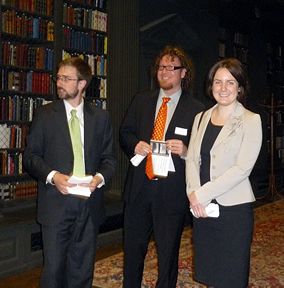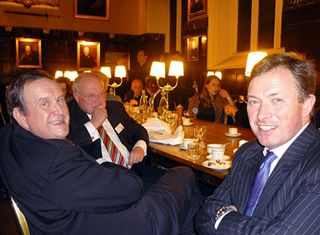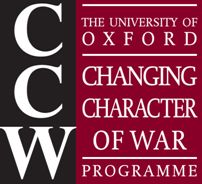Mr. Conor Tucker, Ms. Erin Fitzgerald
A Partnership Between the U.S. Army War College, University of Oxford, and The Australian Land Warfare Studies Centre
 The Strategic Studies Institute of the U.S. Army War College, the University of Oxford Changing Character of War Programme, and the Australian Land Warfare Studies Centre partnered to conduct an international conference entitled “Post-Heroic Warfare?” The conference was held in Oxford, UK, from March 21-23, 2011. It brought together over 200 civilian and military scholars and practitioners from a variety of disciplines and backgrounds to discuss apparent changes in soldier and warrior identities, and to assess the potential strategic and policy implications of those changes. Conference speakers addressed many of the issues raised by Edward Luttwak’s article “Toward Post-Heroic Warfare” (Foreign Affairs. 1995), but also brought more recent issues to light in the course of five sessions: (1) “Heroism and Self-Sacrifice,” (2) “Casualty Aversion,” (3) “Casualty Avoidance,” (4) “Combat Motivation,” and (5) the potential transition from “Heroes to Victims.” A volume of selected conference papers edited by Dr. Sybille Scheipers will be published by Oxford University Press. The following is a summary of each of the panels and presentations.
The Strategic Studies Institute of the U.S. Army War College, the University of Oxford Changing Character of War Programme, and the Australian Land Warfare Studies Centre partnered to conduct an international conference entitled “Post-Heroic Warfare?” The conference was held in Oxford, UK, from March 21-23, 2011. It brought together over 200 civilian and military scholars and practitioners from a variety of disciplines and backgrounds to discuss apparent changes in soldier and warrior identities, and to assess the potential strategic and policy implications of those changes. Conference speakers addressed many of the issues raised by Edward Luttwak’s article “Toward Post-Heroic Warfare” (Foreign Affairs. 1995), but also brought more recent issues to light in the course of five sessions: (1) “Heroism and Self-Sacrifice,” (2) “Casualty Aversion,” (3) “Casualty Avoidance,” (4) “Combat Motivation,” and (5) the potential transition from “Heroes to Victims.” A volume of selected conference papers edited by Dr. Sybille Scheipers will be published by Oxford University Press. The following is a summary of each of the panels and presentations.
DAY 1
Keynote Lecture.
Hew Strachan’s keynote lecture outlined the questions which were explored during the conference. He began his analysis with an almost clichéd phrase: “He died doing a job he loved.” This phrase is not, at first glance, interesting. It is only in the other possibilities that the answer may be seen as a question in disguise. Why didn’t he die for his country; or his political beliefs; or his comrades?
A “job” suggests a profession, and thus a separation from society. More and more, Strachan argued, militaries “of the West” have separated their soldiers from their society. From the French Revolution, where the ordinary man was transformed from an “automaton” to a “hero” by his participation in a political conflict, to the First World War, where the “political education” of the ordinary man was thought necessary for morale, the role of politics as a combat motivation is evident. But democratic and martial values now seem in tension, and the transition from political motivation to financial (or occupational) motivation is obvious. What happened in the last century to cause such a transition? And what does it mean for polity that there is a separation between the values of its soldiers, and the values of its society.
Session One.
 This session focused on combat motivation — from historical changes to modern motivations and future problems. During the Napoleonic Wars, there was an intimate connection between politics and motivation, but this rarely was articulated with nationalist rhetoric and still did not eclipse the traditional military motivations of comrades and commanders. In the American Civil War, “heroism” played a rhetorical as much as a motivational role, as both sides attempted to capitalize on notions of heroism to consolidate their political support and successes. In this case, and in most every case, the dichotomy between “good” and “evil” is important both for the production of legitimacy and the maintenance of morale.
This session focused on combat motivation — from historical changes to modern motivations and future problems. During the Napoleonic Wars, there was an intimate connection between politics and motivation, but this rarely was articulated with nationalist rhetoric and still did not eclipse the traditional military motivations of comrades and commanders. In the American Civil War, “heroism” played a rhetorical as much as a motivational role, as both sides attempted to capitalize on notions of heroism to consolidate their political support and successes. In this case, and in most every case, the dichotomy between “good” and “evil” is important both for the production of legitimacy and the maintenance of morale.
Wars of national liberation (both historic and present) rely on acts of heroism, charismatic leaders, and mass mobilization. However, these identities and attributes are in flux: they are constantly being created, recreated, managed, and contested.
In the Cold War, the development of strategic nuclear weapons and M.A.D. shook the raison d’être of the U.S. Army as an institution. Effort was shifted to the budget battles. But after Vietnam, Air-Land Battle revived the Army and gave the Army back an image of the warrior hero which had been eroded. Vietnam was, in itself, the demise of the citizen soldier as the United States recruited the “upper class” into universities and the “lower class” into the military. However, the idea that Vietnam is “post-heroic” needs to be revised on the micro-level. Men experienced the war heroically (but felt prevented from acting heroically, developing “fear” and “rage” reactions to the Viet Cong tactics) and their letters suggest a high level of casualty tolerance.
Cosmopolitan values are often considered as the foundation of humanitarian intervention. However, cosmopolitanism may present a fundamental problem to the conduct of warfare. On the one hand, cosmopolitanism protects against the temptations of “othering” and the construction of a “good versus evil” dichotomy. This makes it more acceptable as a political narrative and can have a restraining influence on the conduct of war. On the other hand, it is questionable whether it actually can sustain campaigns.
DAY 2
Session 2.
 Session two dealt mainly with the role of casualties in warfare. Sebastian Kaempf vigorously defended the notion that Vietnam marked the transition from a casualty accepting to a casualty avoiding form of warfare. The individual soldier became so disenchanted by Vietnam that he could no longer realize war as a meaningful human activity: the troops were without agency, were alienated, and couldn’t engage with their enemy as previous generations of soldiers could.
Session two dealt mainly with the role of casualties in warfare. Sebastian Kaempf vigorously defended the notion that Vietnam marked the transition from a casualty accepting to a casualty avoiding form of warfare. The individual soldier became so disenchanted by Vietnam that he could no longer realize war as a meaningful human activity: the troops were without agency, were alienated, and couldn’t engage with their enemy as previous generations of soldiers could.
Peter Feaver explained the relevance of leadership and goals with respect to the question of casualty aversion in the United States: strong leaders can help shape public reaction to casualties; success (and the realistic possibility of success) is more important than legitimacy and casualties in public opinion.
Susan Carruthers’ presentation problematized the issue of casualties. The commonplace explanation of the Vietnam War comes from Sir Robin Day: “Blood looks very red on the television screen.” However, two caveats should be understood: casualties are not unambiguous, and policymakers’ aversion to the reproduction of images of the dead needs to be historicized. Casualties can motivate soldiers and public opinion to finish a war, as the Roosevelt Administration had hoped when it started releasing pictures of dead soldiers on Japanese Islands. Casualty exclusion (rather than aversion) goes all the way back to the First World War — when Americans tried to keep pictures of the Somme out of U.S. newspapers for fear it would hurt recruitment.
Session 3.
 Session three addressed the means for avoiding casualties. The use of private security companies (PSCs) is a case in point, because it minimizes the visibility of U.S. mobilization. As Deborah Avant’s research showed, however, the U.S. public’s casualty sensitivity extends to PSCs regardless of the nationality. Hence, if transparency regarding the use of PSCs increases, PSCs will cease to reduce casualty sensitivity among the American public and, by extension, U.S. policymakers. Antulio Echevarria discussed the evolution of stand-off warfare, and asked to what extent the development of nano and biotechnologies may re-define rather than merely refine standoff itself, and whether the end result will be as riskless and discriminatory as some advocates claim.
Session three addressed the means for avoiding casualties. The use of private security companies (PSCs) is a case in point, because it minimizes the visibility of U.S. mobilization. As Deborah Avant’s research showed, however, the U.S. public’s casualty sensitivity extends to PSCs regardless of the nationality. Hence, if transparency regarding the use of PSCs increases, PSCs will cease to reduce casualty sensitivity among the American public and, by extension, U.S. policymakers. Antulio Echevarria discussed the evolution of stand-off warfare, and asked to what extent the development of nano and biotechnologies may re-define rather than merely refine standoff itself, and whether the end result will be as riskless and discriminatory as some advocates claim.
Session 4.
 Session Four dealt specifically with the issue of the “hero.” There is a reciprocal relationship between conscript armies and heroes. Since conscript armies are mainly made of citizens rather than professional soldiers, they are more likely to tend towards cowardice in the face of their first experience with the destructive power of modern warfare. At the same time, this provides opportunities for instances of individual heroism: NCOs, officers, and special weapons handlers lead by example. In modern all-volunteer forces, the actions of the hero are the expected actions; heroism, without its complement of cowardice, simply becomes professionalism.
Session Four dealt specifically with the issue of the “hero.” There is a reciprocal relationship between conscript armies and heroes. Since conscript armies are mainly made of citizens rather than professional soldiers, they are more likely to tend towards cowardice in the face of their first experience with the destructive power of modern warfare. At the same time, this provides opportunities for instances of individual heroism: NCOs, officers, and special weapons handlers lead by example. In modern all-volunteer forces, the actions of the hero are the expected actions; heroism, without its complement of cowardice, simply becomes professionalism.
Heroes are essentially normative concepts: applied for a variety of reasons to a variety of individuals by a variety of persons. Thus, Massoud (the “Lion of Panjir”) represents a hero to the United States in a different way than he does to his own people.
Keynote Lecture: Nancy Sherman.
Sherman’s lecture started with a tender story concerning the dog tags of her father. He never talked about his experiences in World War II, and she never knew how much it meant to him until she found his dog tags after he died. The dog tags form a convenient metaphor for Sherman’s lecture: the little things of great importance that are carried by soldiers which are rarely communicated.
Sherman became interested, after this experience, in the moral aspect of psychological dissonance, or more specifically the attribution of moral blame for something which one is not morally blameworthy. She explains, using relevant examples, multiple different types of this activity in modern wars: accident guilt, survivor guilt, causal (but not moral) responsibility, and luck guilt. These aspects of soldiering — perhaps incorrect, moral burden that each soldier carries — need to be talked about and dealt with. Otherwise, in a paraphrase of Nietzsche, bad conscience can become torture without end.
DAY 3
Session 5.
 The last session of the conference dealt with the representation of the soldier at the intersection of medical and political discourses. The soldier-hero in the First World War represented the epitome of masculinity and imperial power. Because of this, the psychological problems associated with modern industrial warfare were taken for weaknesses in character and misunderstood by military authorities.
The last session of the conference dealt with the representation of the soldier at the intersection of medical and political discourses. The soldier-hero in the First World War represented the epitome of masculinity and imperial power. Because of this, the psychological problems associated with modern industrial warfare were taken for weaknesses in character and misunderstood by military authorities.
The concept of psychological harm started with the notion of shell shock. In the culture of militarism in Edwardian England, shell shock was construed as a metaphor for “unmilitary behavior” (Peter Barham). In fact, the term was banned from military discourse. At the same time, and against the background of the expansion of social rights to the working class, claims for medical care for military personnel grew stronger.
In Vietnam, the “location” of the malady was placed in the human mind: all men would display psychological difficulty with sufficient exposure to battlefield experiences. Thus the U.S. Administration decided to introduce 1-year tours in Vietnam to break up the exposure of individuals to war. However, this tended to undermine group unity and cohesion as an important source of combat motivation.
The development of a professional code of ethics by the U.S. Army is an attempt to illuminate the raison d’être of the Army in a new age of warfare (which Snider and Jennings do not think is “post” heroic at all). This professional code is organized around the code of “to kill under authority and to die for authority and comrades”— a code that is similar to that of the police (“to serve and protect”) and meant to explicitly link the Army to its function of defending society with an expert application of military skills and training.
Commemoration in the post-modern era has become as much about performance as about remembrance. Monuments are now made for interaction (parks, prayer walls, etc.) and museums have become more popular.
This summary was developed out of the “Post-Heroic Warfare?” Report compiled by Conor Tucker and Erin Fitzgerald, available upon request from the Oxford University Programme on the Changing Character of War.
*****
The views expressed in this brief are those of the authors and do not necessarily reflect the official policy or position of the Department of the Army, the Department of Defense, or the U.S. Government.
*****
More information on the Strategic Studies Institute’s programs may be found on the Institute’s homepage at www.StrategicStudiesInstitute.army.mil.